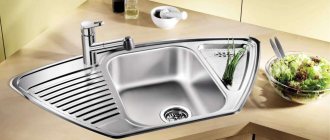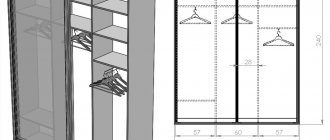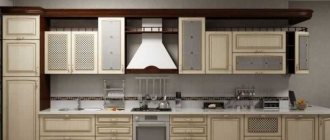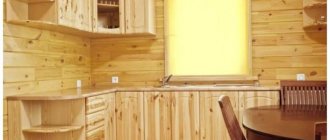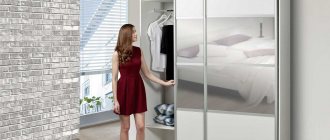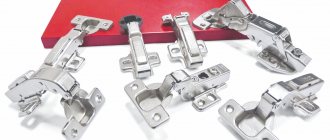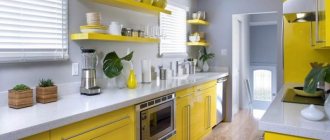Types of filling kitchen cabinets by access method
Kitchen drawer filling systems by access method:
- Retractable systems are considered the most common. They rationally organize the filling of a standard kitchen, economically using the internal space. The mechanism operates on rollers that push the drawers along special grooves or ball guides located at the bottom of the kitchen cabinets. It would be good if the retractable filling systems are equipped with pneumatic closers, which make it easy to open the bedside table;
- Stationary storage systems cost less, but are also not as convenient for filling the kitchen. Cabinets with hinged doors waste a lot of space because they open towards themselves, so they are placed in the lower cabinets of the kitchen unit. Sliding systems move along guides to the right and left. They are not convenient because they do not provide a full overview of the contents inside; they are more often used in large cabinets for dishes. Lifting mechanisms operate on special gas lifts and are used for wall cabinets in kitchen units;
- Open filling systems are a convenient solution for storing items used every day, such as spices, necessary utensils, and useful items. In addition, they can be used to decorate the kitchen. Open filling is often placed in the upper cabinets of kitchen units.
Functionality
Shelves are used for various purposes:
- Decorative part of the interior . The most common option. But this is understandable, because the appearance of the room affects the mood of everyone who is in it.
- Rational element . In this case, with the help of shelves, all the free space in the kitchen is used to the maximum.
- Part of the structure . It’s rare, but it happens that a spice shelf is also the support of a wall cabinet. It can ergonomically fill the gap between the wall and the side of the cabinet.
An example of designing a shelf on an entire wall.
Elements for filling kitchen cabinets for storage
For the internal filling of drawers in the kitchen, various functional elements are used, which help to compactly and neatly store accessories even inside a small space.
Drawer in kitchen unit with dividers
Retractable mechanisms
Pull-out filling systems for kitchen cabinets allow you to quickly remove items inside. In addition to its direct purpose, there is another property - a retractable table or board for cutting food can be built into the large tabletop of the set.
Pull-out filling systems for kitchen cabinets have many advantages:
- Maximum use of the internal space of the headset;
- Suitable for any kitchen interior;
- Different configurations and sizes, the ability to be mounted in any furniture;
- Long service life.
Retractable kitchen filling systems include baskets, various drawers, and bottle holders.
Mesh basket
Mesh baskets for dishes and household items are considered a convenient way to fill kitchen cabinets. They provide convenient access to the filling of the cabinet and can accommodate many items compared to conventional drawers. Types of kitchen filling systems by mechanism of action:
- Multi-tier models are used for standard-sized kitchen cabinets. Special rollers roll out the basket to a certain length or completely;
- Pull-out models are pulled out from a standard kitchen cabinet by hand. The baskets are fixed one or more pieces to the opening doors of the kitchen unit. They are often installed under the sink to make efficient use of space.
Multi-tiered roll-out mesh basket
Chrome mesh baskets are more practical and reliable. Sometimes bronze designs, which are popular in classic interiors, are chosen to match the kitchen design.
Bottlemakers
Bottles in the kitchen are stored in special bottle holders or cargo containers, which are made in the form of narrow chrome-plated wire baskets. To place them, the upper and lower cabinets of the kitchen unit are used. Bottle containers are used to store jars of seasonings, vegetable oil, vinegar, and sauces. Regular shelves do not have enough height, but the cargo will fit everything you need for cooking. Low containers are placed in the upper section, and the lower section is intended for bottles. There are models with three sections for storing many small cans. If cargo is used only for bottles, then it is recommended to take one compartment with a towel holder.
The placement of the bottle storage compartment depends on its purpose. If alcohol will be stored in it, then it can be mounted in the bar counter or the upper cabinet of the kitchen unit, if sauces, seasonings and spices - in the lower cabinet next to the oven or hob.
Column cabinets
Floor-to-ceiling column cabinets hold a variety of kitchen utensils while taking up little space. They are installed only in spacious dining rooms, as they look too bulky in small kitchens. If there is free space, a row of pencil cases is placed to accommodate household appliances and all kitchen utensils.
A column cabinet frees the kitchen from unnecessary things, but everything is within easy reach. Any item can be easily reached, since the entire cabinet rolls out on ball mechanisms, providing convenient access to the contents. You can install up to 6 large baskets in a high pencil case, putting cutlery, heavy frying pans, and stewpans in them. The grids are made of stainless steel, which increases the service life. One basket can support up to 20 kg of weight, and the column cabinet can hold up to 120 kg.
Drawers under the oven
The oven in the kitchen is installed at eye level, and under it there is a retractable filling system for storing frying pans, sauté pans, and baking dishes up to 25 cm high. It must extend completely and not sag under the weight of the dishes. Using drawers under the oven is suitable for a small kitchen, since retractable systems for storing accessories are always more functional than hinged ones.
Cutlery trays
Trays can have a different number of sections: large - for forks and spoons, small - for tea and dessert utensils, medium - for knives, long - for spatulas. Usually they are placed in a drawer under the kitchen countertop, with holes made for natural ventilation. To drain moisture, a special tray is installed under the tray. Wood, steel, and plastic are usually used for manufacturing. Metal and wooden trays last longer, while plastic ones quickly lose their original appearance, but they have a large selection of colors and are easy to clean from dirt.
Trays for pans and pots
Storage systems for pots and pans are often located in the lower pull-out drawers of kitchen units. Items are securely fixed inside using holders and do not move when the cabinet is opened. The inserts can be easily rearranged based on the size of the dishes.
Lifting mechanisms
Hanging cabinets in kitchen units are equipped with lifting mechanisms, which avoids the option of doors opening in two directions. The door opens upward, and special latches hold it in the open position. The principle of operation of the mechanism resembles a kind of elevator.
Dryer
The drying rack is used to store small and deep dishes in the kitchen. It is advisable to choose it with a tray for draining water from wet dishes. Built-in models are installed inside wall cabinets of kitchen units, where dust does not fall on objects; for independent ones, they choose any convenient place in the kitchen, taking into account the free space for the tray. It is a good idea to place the dryer in a corner cabinet above the sink, where the temperature is higher and natural ventilation is more effective. It can also be placed in the lower bedside table using the deep drawer in the kitchen unit. The dryer can withstand up to 20 kg of weight. Usually made of durable wire, the surface of which is protected by a chrome-plated layer to prevent corrosion.
Bin
Garbage bins in the kitchen are equipped with retractable structures, various pedals, and valves that allow you to remove them automatically. Containers are usually mounted in the lower cabinets of kitchen units. If you want to install more than one bucket in the kitchen, choose a rotating design that allows you to sort waste.
Railings
A rail is a pipe or crossbar attached to the base of a wall on which kitchen utensils are hung. The number of hooks and the distance between them can be adjusted independently. The design allows you to free up the internal space of the drawers in the set. Despite the fact that all items are located openly, this does not spoil the look of the kitchen.
Types of roof rails for the kitchen:
- Horizontal models from one or several departments are hung just below the wall cabinets;
- Vertical crossbars are installed from floor to ceiling; there are several shelves on them;
- Hanging rails are screwed to the ceiling above the kitchen countertop.
Made from plastic, aluminum or steel. Steel ones are more durable, they can withstand temperature changes and do not rust.
DIY spice racks
You can easily make spice racks yourself and decorate them using the decoupage technique. This is done quickly and easily. The only tools you need are an electric jigsaw, a drill, a grinder and a screwdriver. You also need to purchase several wooden boards made of pine or spruce, a set of screws and enamel to coat the final product. The thickness of the boards is maximum 3 cm. A shelf measuring 50*50 cm is made of five bars 50 centimeters long. Of these, three are the shelves themselves, and two are the side walls.
The side elements can be made in an interesting style: drawing, ornament, carving. You can come up with it yourself or look for options on the Internet. The boards under the shelves must be level so that the spices stand on them steadily.
Operating procedure:
- Each of the manufactured elements is sanded using a machine or sandpaper.
- Assembly is carried out after all the necessary holes are drilled with a drill.
- The fittings are connected using self-tapping screws and a screwdriver.
- For reliability, you can use metal construction corners between the perpendicular elements of the shelf.
- The final product is treated with varnish.
The spice rack is ready. Using experience and imagination, you can make several of these attributes for your kitchen interior, as well as make your loved ones and friends happy.
Features of filling corner cabinets in the kitchen
A corner cabinet allows you to rationally use the interior space of the set. If necessary items are lost in deep niches, then modern kitchen filling systems make it easier to find:
- Rotating carousels are often installed in corner cabinets, since it is in them that the most usable space is lost. When you open the door, the desired item is at hand, there is no need to look for anything in the depths. The carousel consists of semicircular shelves moving around an axis at 270 degrees, the radius of which depends on the capacity of the kitchen cabinets. It can be installed in both the lower and upper corner cabinets. The rotating carousel is attached in different ways and has different extension angles.
- The round shelves of the carousel can fit entirely into a niche or move forward when the door is opened. They have a plastic base with metal edges, and mesh edges with semicircular ones. A metal carousel holds an impressive weight, while a plastic carousel is not particularly durable;
- The corner section is attached to a cabinet or retractable kitchen cabinet. The mechanism consists of two baskets with hanging elements, which practically repeats the operation of the carousel, but holds more dishes. One mesh is fixed to the door, the second is placed inside. When closed, the corner section is located in the cabinet, and when the door is opened, it rolls forward along the guides, providing access to the contents. This kitchen filling is also called a magic corner; it is made of steel wire, which ensures strength and durability.
In corner kitchen cabinets with one door, a pull-out filling system is installed, which allows quick access to the contents. Instead of a trash can, a bracket with a durable bag is hung from the inside of the door, which is replaced with an empty one as it is filled.
Where to mount on which kitchen wall
- The wall on which the open shelves will be attached should not attract much attention. Shelves should not be installed near bright surfaces with rich patterns.
- You cannot install shelves above the stove during planning, otherwise there is a risk of food particles, grease and steam getting on them.
- Small shelves can be installed above the dining table.
- Several shelves above each other are a combined module of rail holders. One shelf can be used for cute accessories, and the rest for necessary little things.
If elegant mugs, bright plates, original teapots and saucepans will be stored on the shelf, then it is better to mount it against a beige or gray wall. The snow-white elements of the services contrast perfectly with the dark background. The wall can be chocolate or light brown.
Open shelves
Open shelves have the following advantages:
- Even a guest can easily find seasonings, utensils and other items.
- Thanks to the ability to choose the mounting height, the shelves are easier to access - unlike cabinets, the top of which is difficult to reach.
- Installation and dismantling of open shelves is easy and does not require calling a furniture specialist.
- Due to the smaller depth, kitchen space is saved.
- Versatility: on such shelves you can store anything you want - plates, pots, cereals, drinks, spices, etc.
- Due to the lack of a facade, the price of open upper shelves is several times lower than closed cabinets.
Minuses:
- dust accumulates;
- Carbon deposits occur when the exhaust power is insufficient.
In addition, open shelves are less functional. Because of the light, products that are sensitive to the sun should not be placed on them. Large household appliances such as an electric meat grinder or food processor cannot be placed on such shelves. The fastenings may fail and the shelves will fall.
On open shelves are placed:
- decorative and beautiful everyday tableware;
- seasonings;
- bulk dry products - vermicelli, cereals, flour;
- sugar bowl, salt-pepper shaker-napkin holder set;
- decorative elements - clocks, candles, vases;
- kitchen scales;
- small household appliances, for example, mixer, blender;
- trays;
- dishes, candy bowls, cake bowl;
- teapot;
- detergents;
- bottles.
Cargo instead of stands
If you've done any kitchen renovations, you're familiar with the problem: a gaping gap between the cabinets and the stove. Previously, the issue was solved by nailing a shelf-stand for ease of cooking: stir the soup and put the ladle on it. But the entire depth of the gap was not used, and the free space was simply wasted. An unforgivable mistake, especially if we are talking about a cramped kitchen in a Khrushchev-era building.
A modern solution to the problem is narrow retractable Cargo systems. They hold a lot of small items: bottles of oil and vinegar, boxes of tea and coffee, jars of cereals and seasonings. And if the width of the box allows, then saucers and even plates.
The Cargo mechanism extends 100%. You don’t have to put your hand into a narrow drawer and look for the right thing by touch - everything will be in sight.
Corner drying instead of straight
This option is suitable for owners of corner sinks. A modern designer will suggest that you arrange the drying rack in the letter “L”: the long part is for plates, the short part is for cups and glasses. Thanks to such drying, housewives do not have to reach far to put down the washed dishes.
The kit includes stainless steel drip trays and plastic fasteners that secure the system to the wall or inside the cabinet. If your doors are always open to guests, your option is a wide two-story drying rack.
